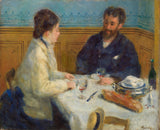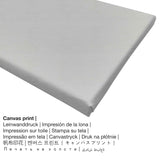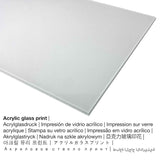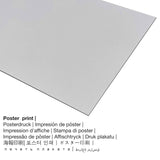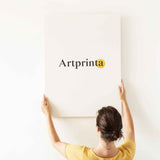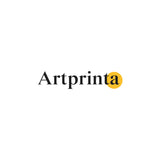Pierre-Auguste Renoir, 1875 - Luncheon (The Luncheon) - fine art print
Tax included. Shipping calculated at checkout.
(© Copyright - by Barnes Foundation - Barnes Foundation)
A man and a young woman are seated in the corner of a room, at a table laid out for a meal. We see a baguette and a closed tureen with a napkin on top of it, and, beside it, a wine bottle and a smaller container, perhaps for oil. Each figure has a glass containing a little red wine; the man holds his glass, while the woman holds what is perhaps a knife, but we cannot see what she might be preparing to cut; another, sharp, knife lies on the table beside the bread, which is the only visible foodstuff. They are seated in front of a wall with a paneled light brown dado and, above, light blue wallpaper with a simple, regular geometric decorative border. The man is very informally dressed, with an open collar and a loose blue cotton jacket, suitable garb for a canotier, while the woman wears a light jacket over a quite elaborate blue dress with a full skirt—a respectable walking dress. In the foreground, we see part of a third chair, with a man's boater hanging from it; turned away from the table, with no place setting in front of it, this chair cannot be seen as opening a space that invites the viewer, in imagination, to take his or her place at the table. This is evidently a dejeuner a deux.However, despite the range of details included, the picture gives us little clue about the setting or the relationship between the figures. We cannot tell whether they are in a private home or a modest restaurant; they look toward each other, but there are no obvious signs of intimacy or clues to the nature of their relationship. The man wears a ring on the little finger of his left hand, while no rings are visible on the woman's fingers. At this date, such images of a man and a woman alone together would conventionally have offered cues to viewers that would have allowed them to interpret the scene in terms of some sentimental anecdote or amorous interchange; indeed, when Luncheon was sold at auction in 1900, the sale catalogue interpreted it in just such terms: "He and she interrupt their meal. A quiet joy rises from their heart to their eyes. Without speaking, they look at each other. They are deliciously happy about this day when in a little suburban restaurant they can hide, far from Paris, far from gossip."However, the author of this catalogue seems to have been following the conventions of such imagery, rather than attending to the picture itself. For Renoir has studiously avoided including the markers that would have pointed to an interpretation of this sort; the figures do seem to be looking at each other, but their faces have none of the overt expressiveness commonly used to evoke an amorous engagement, and their body language is also very restrained. Renoir's image evokes the impossibility of deciphering the relationships of figures whom one sees in passing in everyday life. The softly brushed paintwork of the two faces further obstructs any reading of their expressions. Throughout the paint is fluently applied, deftly notating, in strokes of various weight and density, the play of light across the objects on the table, which is suggested by white and off-white highlights and by the colored nuances that model the forms. The sharp reds of the wine in the glasses and on the loaf of bread link to the warm hues of the flesh, set off against the blue of the man's jacket and the woman's skirt, and the blue that is used to model the objects on the table. This warm-cool contrast is echoed in the opposition between the dado and the wallpaper.Various dates have been proposed for Luncheon, but Colin Bailey has persuasively suggested that it was painted in the summer of 1875, at the same time as Lunch at the Restaurant Fournaise (The Rowers' Lunch) (Art Institute Chicago), during the spell that Renoir spent at Chatou, on the Seine to the west of Paris. The same male figure, identified by Francois Daulte as M. de Lauradour, a habitue of the Fournaise restaurant, appears in both paintings, and it seems likely that the female figure is the same in both, too, perhaps wearing the same blue dress. John House, Renoir in the Barnes Foundation (New Haven: Yale University Press, 2012), 75.
What you should know this over 140 year-old work of art
In 1875 Pierre-Auguste Renoir painted this impressionist artpiece. The original creation had the following size - Overall: 19 3/8 x 23 5/8 in (49,2 x 60 cm). Oil on canvas was applied by the artist as the medium of the masterpiece. This artwork can be viewed in in the digital collection of Barnes Foundation, which home to one of the world's greatest collections of impressionist, post-impressionist and early modernist paintings. The modern art public domain piece of art is included with courtesy of Courtesy of the Barnes Foundation, Merion and Philadelphia, Pennsylvania.The creditline of the artwork is: . Furthermore, alignment is in landscape format and has a side ratio of 1.2 : 1, which means that the length is 20% longer than the width. The illustrator, painter, sculptor Pierre-Auguste Renoir was an artist, whose style was mainly Impressionism. The European artist was born in 1841 in Limoges, Nouvelle-Aquitaine, France and died at the age of 78 in 1919 in Cagnes-sur-Mer, Provence-Alpes-Cote d'Azur, France.
Order the material you would like to have
We offer a range of various materials and sizes for every product. We allow yout to choose among the following variants:
- Printed poster (canvas material): Our poster print is a printed sheet of flat canvas paper with a nice structure on the surface. A poster is used for framing your fine art print using a special frame. Please bear in mind, that depending on the size of the poster print we add a white margin between 2-6cm around the print motif in order to facilitate the framing with your custom frame.
- The acrylic glass print (with real glass coating on top): An print on acrylic glass, which is often described as a plexiglass print, will convert your original into lovely décor and is a viable alternative to canvas or dibond fine art replicas. Our real glass coating protects your chosen art print against sunlight and external influences for many years to come.
- Canvas print: The canvas print is a printed cotton canvas stretched on a wooden stretcher. Further, a canvas generates a soft and comfy appearance. Canvas prints are relatively low in weight, meaning that it is easy and straightforward to hang up your Canvas print without extra wall-mounts. Canvas prints are suitable for all kinds of walls.
- Aluminium dibond print (metal): An Aluminium Dibond print is a material with an outstanding effect of depth. For the Aluminium Dibond option, we print your favorite work of art onto the aluminium surface. Colors are luminous in the highest definition, fine details of the print are crisp and clear. This direct UV print on Aluminum Dibond is the most popular entry-level product and is a truly contemporary way to display artworks, because it draws focus on the whole artwork.
The artist
| Artist: | Pierre-Auguste Renoir |
| Alias names: | Renoar Pjer-Ogist, Auguste Renoir, Renoir August, Pierre-Auguste Renoir, a. renoir, renoir p.a., pierre august renoir, Renoir Auguste, Renoir, p.a. renoir, firmin auguste renoir, רנואר פייר אוגוסט, Renoir Pierre August, Pierre Auguste Renoir, Renoir Pierre-Auguste, רנואר אוגוסט, August Renoir, renoir a., Renoir Pierre Auguste, Renuar Ogi︠u︡st |
| Gender of the artist: | male |
| Artist nationality: | French |
| Jobs: | painter, sculptor, illustrator |
| Country of the artist: | France |
| Artist category: | modern artist |
| Art styles: | Impressionism |
| Life span: | 78 years |
| Year born: | 1841 |
| Birthplace: | Limoges, Nouvelle-Aquitaine, France |
| Died: | 1919 |
| Place of death: | Cagnes-sur-Mer, Provence-Alpes-Cote d'Azur, France |
Structured artwork data
| Piece of art title: | "Luncheon (The Luncheon)" |
| Categorization: | painting |
| General term: | modern art |
| Artwork century: | 19th century |
| Artpiece year: | 1875 |
| Approximate age of artwork: | around 140 years old |
| Painted on: | oil on canvas |
| Artwork original dimensions: | Overall: 19 3/8 x 23 5/8 in (49,2 x 60 cm) |
| Exhibited in: | Barnes Foundation |
| Location of the museum: | Philadelphia, Pennsylvania, United States of America |
| Website of the museum: | www.barnesfoundation.org |
| Artwork license: | public domain |
| Courtesy of: | Courtesy of the Barnes Foundation, Merion and Philadelphia, Pennsylvania |
Structured item details
| Print product type: | art print |
| Reproduction method: | digital reproduction |
| Production technique: | UV direct print |
| Manufacturing: | produced in Germany |
| Stock type: | on demand production |
| Product use: | wall art, wall décor |
| Alignment: | landscape format |
| Aspect ratio: | 1.2 : 1 |
| Interpretation of aspect ratio: | the length is 20% longer than the width |
| Available product fabrics: | canvas print, poster print (canvas paper), metal print (aluminium dibond), acrylic glass print (with real glass coating) |
| Canvas print (canvas on stretcher frame): | 60x50cm - 24x20", 120x100cm - 47x39" |
| Acrylic glass print (with real glass coating): | 60x50cm - 24x20", 120x100cm - 47x39" |
| Poster print (canvas paper): | 60x50cm - 24x20", 120x100cm - 47x39" |
| Aluminium print: | 60x50cm - 24x20", 120x100cm - 47x39" |
| Art print framing: | not included |
Legal disclaimer: We do whatever we can to depict our products as exact as possible and to display them visually in our shop. Although, the pigments of the print materials, as well as the printing might differ to a certain extent from the representation on the device's screen. Depending on the screen settings and the quality of the surface, not all colors can be printed as exactly as the digital version shown here. Bearing in mind that the art reproductions are printed and processed manually, there might as well be slight variations in the exact position and the size of the motif.
This text is intellectual property and protected by copyright ©, Artprinta (www.artprinta.com)

